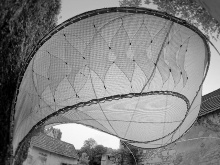Performative Morphology
ICD/ITKE Research Pavilion 2017
The essential objective of the design studio is to combine the material specific research and state of the art robotic fabrication technology review into an architectural application and concept for on-site ongoing fabrication of a composite, tensile construction. This research pavilion will be constructed between the K1 and K2 university buildings.
Tensile hybrid systems in production become a live expression of forces seeking an equilibrium condition. Typically, tensile hybrid systems are designed for a single pre-designed state of equilibrium, which is only achieved at the very end of construction. Design investigations and concepts for subsequent materialization will question whether a tensile hybrid design system can have multiple stages of equilibrium. How can the utilization of stiffening or bending active elements, which through their processes of formation, act together to enable stability at all stages of production? Can behavioral or rule based logics of formation, enacted by a robot or machine connected to digital design data and form finding techniques, enable this to occur, limiting or eliminating the need for secondary formwork?
During this phase, the goal will be to develop an onsite and integrated fabrication strategy for live ongoing production and assembly, considering various strategies of adaptivity or collective construction. For example, the robots role in the process may not merely be to process parts, but to act as a precision instrument which both senses and gathers information relating to construction. This data will be processed and applied, combined with behavioral rule based logics for applying loads precisely where they are needed to form the bending active elements or pre-stress tensile elements. These adaptive forming processes will be related to a strategy for assembly and construction sequencing. In this case, the geometric specificity of the system during production may not be the a priori goal, but rather, the particular effect that each addition or modification has on the equilibrium condition of the existing structure. Computer vision systems and force feedback may be used to help to ascertain when target equilibrium or local mechanical conditions are achieved.
To further augment this process, we will also consider embedded sensing: in which dynamic data can be gathered and embedded from within the structure itself. Embedded sensing could be leveraged to inform the fabrication and assembly strategy adaptively, both as a means to validate the simulation, ensuring a veracity between the digital and the physical. But also as a means to measure local performance: to show what local areas need to be reinforced or actuated, and what operations should be done in what sequence.


